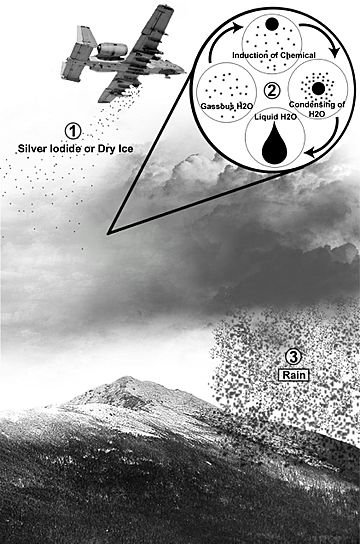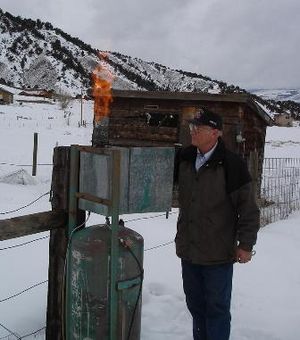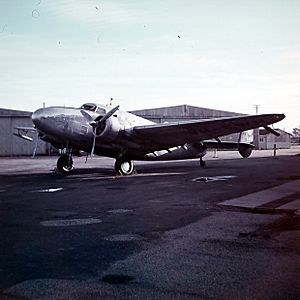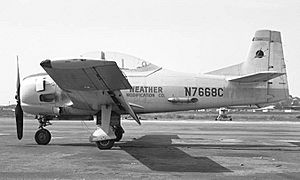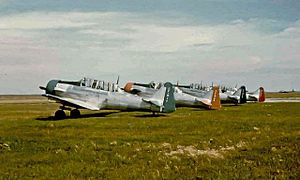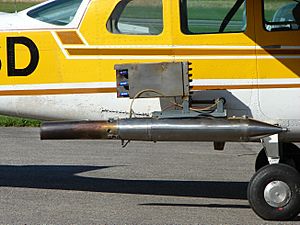Cloud seeding facts for kids
Cloud seeding is a way to change the weather. It tries to make more rain or snow fall from clouds. It works by putting tiny particles into the air. These particles act like tiny magnets for water, helping water droplets or ice crystals form inside clouds.
Scientists still discuss how well cloud seeding works. Some studies say it's hard to prove it has a big effect. The main goal is usually to get more rain or snow. Sometimes, it's used to make it rain sooner, so it doesn't rain later when it's not wanted, like during a big event.
Contents
How Cloud Seeding Works
Using Chemicals
The most common chemicals used for cloud seeding are silver iodide, potassium iodide, and dry ice (which is solid carbon dioxide). Sometimes, liquid propane is also used. It can create ice crystals even in warmer clouds. Recently, scientists have also started using materials that absorb water, like table salt.
For cloud seeding to increase snowfall, the clouds need to be very cold, usually between -20 and -7 degrees Celsius. Silver iodide is often used because its crystals look a lot like ice crystals. This helps new ice crystals form in the cloud.
In clouds that are not too high, the idea is that ice particles grow faster than water droplets. This happens because ice needs less water vapor to grow than liquid water. As the ice particles get bigger, they become heavy and fall as rain or snow. This is called "static" seeding.
For summer clouds, especially big, puffy ones called cumulonimbus clouds, "dynamic" seeding is used. This method tries to make the cloud grow bigger and stronger. When water freezes inside the cloud, it releases heat. This extra heat makes the air in the cloud rise faster, which can lead to more rain.
Cloud seeding chemicals can be spread in a few ways. Airplanes can fly through clouds and release special flares that contain the chemicals. Or, machines on the ground can release tiny particles. These particles then float up into the clouds with air currents.
Using Electric Charges
Since 2021, a new method has been tried in the United Arab Emirates. Drones fly into clouds and release electric charges. These charges help air molecules stick together and form water droplets. This method has already caused some rainstorms. For example, in July 2021, a town called Al Ain had 6.9 millimeters of rain after this method was used.
Using Lasers
In 2010, scientists in Berlin, Germany, tested another electronic method. They aimed infrared laser beams into the air above the city. They hoped these laser pulses would help tiny particles form in the air. These particles could then act as "seeds" for clouds.
Does Cloud Seeding Really Work?
Scientists still debate how well cloud seeding works to increase rain or snow. Different studies have shown different results, and experts have different opinions.
A study by the United States National Academy of Sciences did not find strong proof that cloud seeding works very well. A scientist named Rob Jackson said that it might make a little more snow or rain in some places, but it's not a reliable way to greatly increase precipitation. Another study in Wyoming found that cloud seeding might increase snow by up to 3% over a whole winter.
In 2003, the US National Research Council said that science couldn't say for sure which seeding methods work. They noted that even after 55 years of trying, clear scientific proof for big effects from seeding had not been found.
A 2010 study from Tel Aviv University also suggested that common cloud seeding methods, like using silver iodide, don't have much effect on how much rain falls. Another study in 2011 even suggested that airplanes might accidentally seed clouds just by flying through them, as air cools around their wings and propellers.
However, some experts believe that new technology and research are making cloud seeding more reliable. For example, Jeff Tilley, a director at the Desert Research Institute, said in 2016 that cloud seeding is now a dependable way to get more water in many areas. The American Meteorological Society also stated in 1998 that snow from clouds over mountains could be increased by about 10% in some seasons.
Despite these mixed results, cloud seeding was tried during the 2008 Summer Olympics in Beijing, China. The goal was to make it rain before the opening and closing ceremonies, so the events would stay dry. Whether this worked is still debated. One expert, Roelof Bruintjes, said that "we cannot make clouds or chase clouds away."
Is Cloud Seeding Safe for the Environment and Health?
silver iodide is a chemical used in cloud seeding. If people or animals are exposed to a lot of it for a long time, it could cause some temporary health issues. However, many studies have looked into this and found that cloud seeding has very little impact on the environment and health.
This is because very small amounts of silver are used in cloud seeding. These amounts are much less than what industries release into the air every day. Studies have shown that silver from cloud seeding does not build up in the soil, plants, or water in large amounts. Environmental studies in California (1995) and Australia (2004) also confirmed these findings.
Some environmental groups have raised concerns, especially about cloud seeding over natural parks. For example, in Australia, there were worries about how it might affect a small animal called the pygmy possum. However, scientific research has generally shown that the environmental impact is very low.
History of Cloud Seeding
The idea of making it rain is quite old. In 1891, a man named Louis Gathmann suggested shooting liquid carbon dioxide into clouds. In the 1930s, scientists learned more about how ice crystals form in clouds.
In 1946, a scientist named Vincent Schaefer made an amazing discovery. He was trying to create a cloud in a very cold freezer. When he added a piece of dry ice to make it even colder, he saw millions of tiny ice crystals appear! He realized he had found a way to turn super-cooled water (water that is still liquid below freezing) into ice.
Soon after, Schaefer's colleague, Bernard Vonnegut, found another way to "seed" clouds. He discovered that silver iodide crystals look very similar to ice crystals. This means silver iodide can also help ice crystals form in clouds. Both of these methods were quickly put to use in cloud seeding experiments.
The first time natural clouds were changed using cloud seeding was on November 13, 1946, in New York. Schaefer flew in a plane and dropped about 6 pounds (2.7 kg) of dry ice into a cloud. This caused snow to fall in western Massachusetts.
Dry ice and silver iodide are good at changing cold clouds, helping to increase winter snowfall over mountains. They can also help reduce lightning and hail. Using table salt to seed warmer clouds is also becoming popular again. This method helps water droplets in clouds grow bigger, which leads to more rain.
From 1967 to 1972, the US military used cloud seeding in Vietnam. This was called Operation Popeye. They used silver iodide to make the monsoon (rainy) season last longer. This made the ground muddy, which made it harder for vehicles to move.
In the 1970s, a private company tried to increase rainfall in Oklahoma using silver iodide flares. However, the project didn't run long enough to show a clear change.
The US military also tried to change hurricanes in the 1960s with a project called Project Stormfury. They seeded a few hurricanes, and the storms seemed to change a little, but only for a short time. The project stopped because of worries that cloud seeding might accidentally change a hurricane's path or strength, which could harm people.
Several US government groups have supported cloud seeding research since the 1960s. They studied how to increase snowfall in mountains and rainfall in other areas. They worked with universities and other organizations.
In Australia, the Commonwealth Scientific and Industrial Research Organisation (CSIRO) did many cloud seeding tests from 1947 to the early 1960s. They dropped dry ice into clouds and used silver iodide from planes and ground machines. Only one trial in the Snowy Mountains showed a clear increase in rainfall.
A company in Tasmania, Australia, called Hydro Tasmania, also experimented with cloud seeding starting in the 1960s. They wanted to keep their dams full for electricity. Cloud seeding worked very well there. Studies showed that the chemicals used had very little effect on the environment.
Austria has also used silver iodide for hail prevention since 1981, and they still use it today.
Images for kids
-
Beechcraft King Air C90 used for cloud seeding in the United Arab Emirates
See also
 In Spanish: Siembra de nubes para niños
In Spanish: Siembra de nubes para niños



